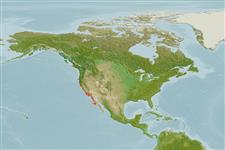>
Blenniiformes (Blennies) >
Clinidae (Clinids)
Etymology: montereyensis: Named after the location for an early collection of this species (Ref. 27436).
Eponymy: Dr William P Gibbons (1812–1897) was a physician and naturalist from Delaware. [...] (Ref. 128868), visit book page.
More on author: Hubbs.
Environment: milieu / climate zone / depth range / distribution range
Ecologia
marinhas demersal; intervalo de profundidade ? - 21 m (Ref. 2850). Subtropical; 51°N - 27°N, 129°W - 114°W
Eastern Pacific: British Columbia, Canada to northern Baja California, Mexico.
Tamanho / Peso / Idade
Maturity: Lm ? range ? - ? cm
Max length : 11.0 cm TL macho/indeterminado; (Ref. 2850)
Descrição suscinta
Chaves de identificação | Morfologia | Morfometria
Espinhos dorsais (total) : 34 - 36; Raios dorsais (total) : 5 - 8; Espinhos anais: 2; Raios anais : 23 - 28; Vértebras: 49 - 51. Caudal rounded (Ref. 6885). Color variable with several phases, reddish, green, dark and silver bars, which intermix freely; there is usually a strong dark ocellus above the lateral line canal behind the pectoral fin and there may be additionally several series of dark spots of various intensities; fins weakly pigmented at bases, anal and pectorals most so; head often with pigment bars radiating from eye (Ref. 6885).
Occurs in inshore rocky areas in algae, usually on exposed coast.
Ciclo de vida ou comportamento de acasalamento
Maturidade | Reprodução | Desova | Ovos | Fecundidade | Larvas
Eschmeyer, W.N., E.S. Herald and H. Hammann, 1983. A field guide to Pacific coast fishes of North America. Boston (MA, USA): Houghton Mifflin Company. xii+336 p. (Ref. 2850)
Status na Lista Vermelha da UICN (Ref. 130435: Version 2024-2)
Ameaça para os humanos
Harmless
Uso pelos humanos
Ferramentas
Relatórios especiais
Baixar XML
Fontes da internet
Estimates based on models
Preferred temperature (Ref.
123201): 10.7 - 19, mean 15.4 °C (based on 85 cells).
Índice de diversidade filogenética (Ref.
82804): PD
50 = 0.6250 [Uniqueness, from 0.5 = low to 2.0 = high].
Bayesian length-weight: a=0.00513 (0.00223 - 0.01182), b=3.06 (2.86 - 3.26), in cm total length, based on LWR estimates for this (Sub)family-body shape (Ref.
93245).
Nível Trófico (Ref.
69278): 3.4 ±0.2 se; based on diet studies.
Resiliência (Ref.
120179): Elevada, tempo mínimo de duplicação da população menor que 15 meses (Preliminary K or Fecundity.).
Fishing Vulnerability (Ref.
59153): Low vulnerability (10 of 100).
